The pandemic forced millions of people to change the way they work.
Wherever possible, companies embraced remote work to keep their employees safe and their businesses open during shelter-in-place orders.
Working remotely during a crisis is totally different, even for companies that were already distributed. Fear, stress, and distractions created a less-than-ideal work environment for the hundreds of thousands of people working from home for the first time.
Newly remote businesses could easily blame work from home arrangements for problems that are actually pandemic-related. Lots of companies experienced predictable drops in productivity, profitability, and morale as the global crisis developed.
Remote work was often thought of as a short-term solution until it was safe to go back to work.
There’s a big difference between working remotely as a good choice for your business and working remotely because it’s the only choice you have.
As restrictions lifted and the U.S. economy started to reopen, companies needed to make major decisions about the future of remote work for their employees.
For many, working from home during the pandemic is the bulk of their experience with a distributed team. Leadership must make long-term decisions based on what they’ve learned so far.
Businesses that survived the initial upheaval are now looking towards the future while still dealing with pandemic conditions.
We wanted to take a closer look at how businesses have adapted so far and what they plan to do when the pandemic eventually recedes. How will the current state of remote work during the pandemic influence how businesses approach working arrangements in the future?
Boost your team’s efficiency with Hubstaff's productivity tools
Survey Methods
We surveyed 400 business owners and managers in the United States about their experiences and plans for the future.
All survey respondents were at least 25 years old and were actively working as a manager or company owner when their state recommended that businesses close for safety.
Out of the 400 survey respondents, 26.75% were age 25-34, 38.5% were age 35-44, 21.0% were age 45-54, and 13.75% were age 55 or older. 52.5% of respondents were male, and 47.5% were female.
The survey asked questions about how their company handled working remotely in response to the pandemic and how they plan to proceed in the future as offices reopen.
Here’s what we found out.

The transition to remote work
There’s no question that the pandemic caused a huge business disruption. Companies had to make quick decisions to keep money coming in without endangering their employees and customers.
However, making the shift to work from home was surprisingly easy for a lot of companies.
Most companies were well prepared to transition easily, and those that weren’t prepared had little trouble adapting.
Looking for more tactical advice?
Subscribe to the Hubstaff blog for more remote work tips.
Remote work was an easy transition
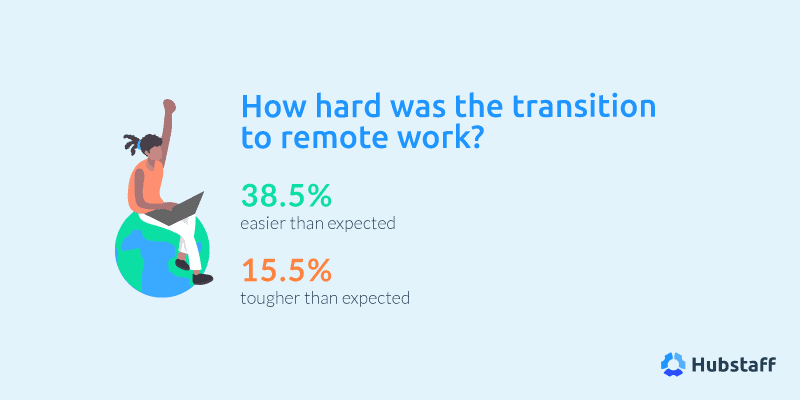
We asked businesses about their transition to remote work. 58% said that they were already equipped to go remote, so it was easy to make the change.
That makes sense. 49% of businesses already allowed employees to work from home in some capacity before the pandemic, so they had at least some remote infrastructure in place.
For the other businesses who weren’t ready for remote work, it still wasn’t a difficult transition. 38.5% of companies said that they quickly adapted to remote work despite not being prepared.
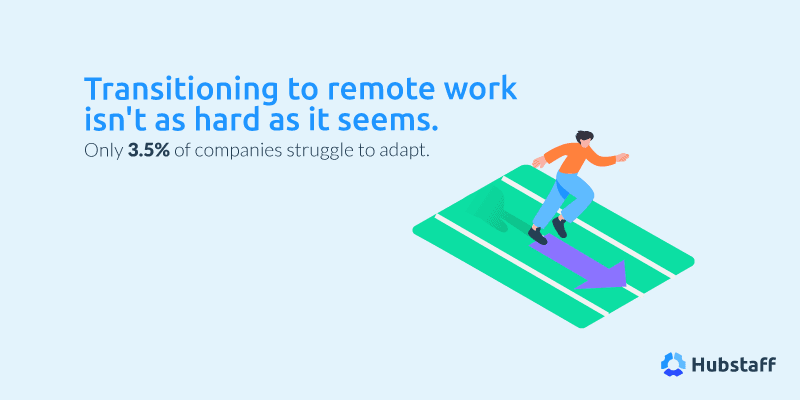
A lot of companies (38.5%) were pleasantly surprised by how easy it was to make the move, while only a few (15.5%) found it tougher than they expected.
These numbers tell an interesting story.
A majority of these companies had to act quickly under extreme pressure, and they still didn’t have trouble moving to remote work.
That doesn’t imply that businesses are having an easy time adapting to the current pandemic economy overall. There are plenty of other challenges to deal with right now.
Fortunately, going remote wasn’t a major problem.
The state of remote work during COVID-19
COVID-19 closures brought remote work to the forefront, but working from home was still fairly common before the pandemic started.
Out of the companies surveyed, almost a quarter of them (23.25%) already considered themselves remote companies before the pandemic began. Another 25.25% offered their employees some flexible remote work options or had a partially remote workforce.
Before the pandemic, 51% of companies did not allow remote work at all.
After shelter-in-place orders were issued, 74.5% went entirely remote.
Out of the remaining 25.5% that aren’t fully remote, some are partially remote. Others provide services that can’t be done remotely. A few respondents reported that their business is entirely closed until it’s safe to reopen again.
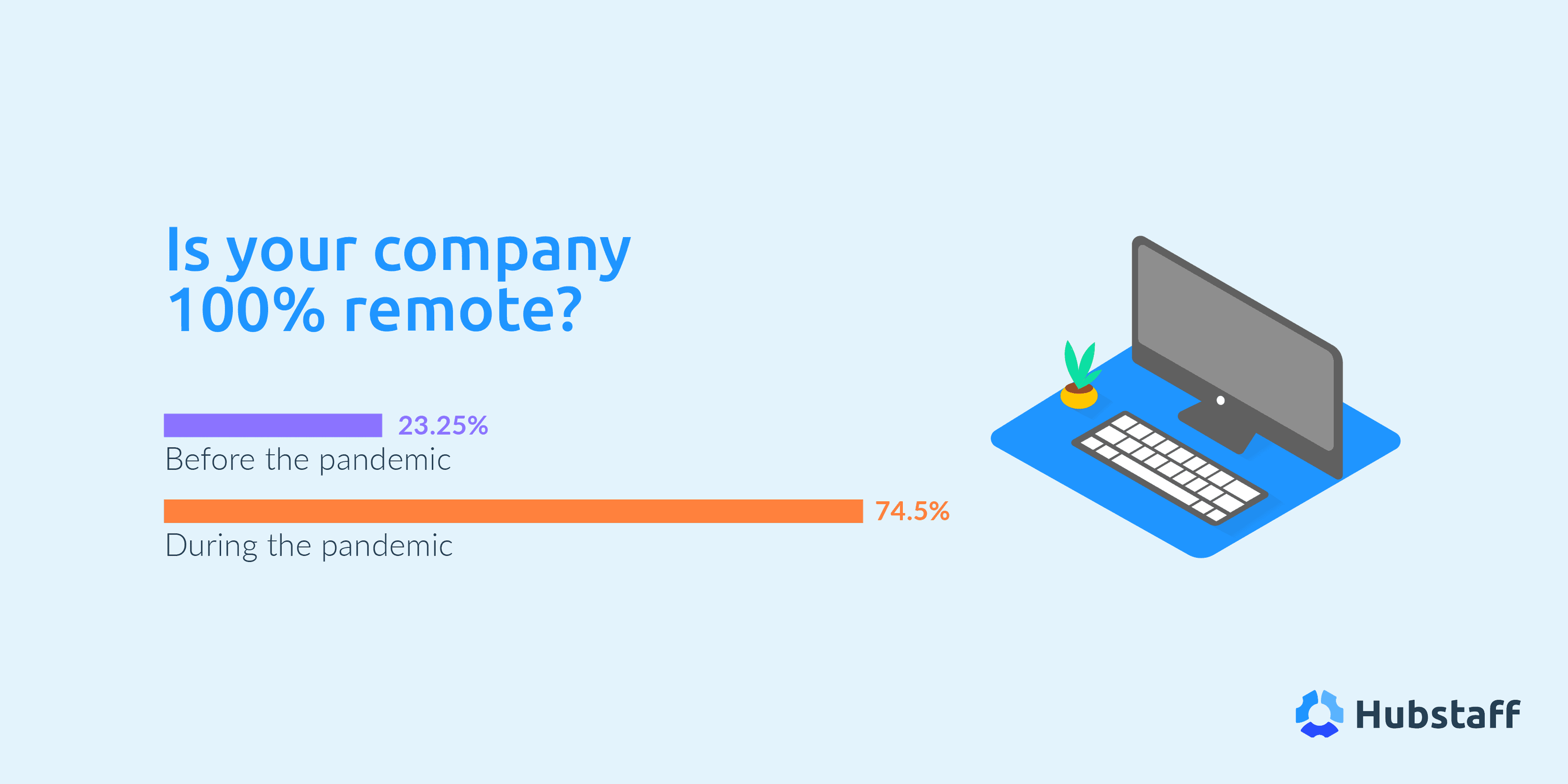
Employees enjoy remote work, even during a pandemic
While the circumstances are less than ideal, this big shift towards remote work might be welcome.
Employees frequently requested remote options before the pandemic forced offices to close. 71.5% of companies reported that their employees have previously asked to work from home at least sometimes.
Employees love remote work. They ask for it often and have responded very positively to working from home during the pandemic.
Most businesses report that their team has responded very positively to their new work environment.
We asked companies to rate their employees’ responses to remote work on a sliding scale, and almost half selected the most positive possible rating. Very few report that their employees have a negative view of working from home during COVID-19.
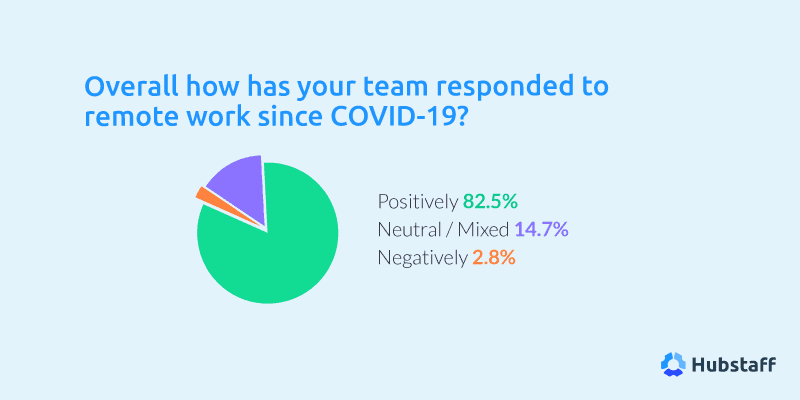
Based on these responses, we can conclude that remote work is very popular among employees. It’s frequently requested and positively received, even under these stressful pandemic circumstances.
Remote work prevented layoffs
Working from home has been a huge help for a lot of companies.

We were happy to discover that remote work has helped companies keep more people employed, with 66% of companies reporting that it helped prevent layoffs.
Note that some of the companies that used remote work to prevent layoffs may still have reduced their workforce. In those cases, the ability to work from home made it possible to keep more people employed despite the need to downsize.
The future of post-pandemic remote work
COVID-19 continues to impact the economy and the way we work.
It’s impossible to estimate when the pandemic will end. But that doesn’t mean we shouldn’t look towards the future.
In the US, reopening is underway with a variety of recommendations and restrictions. Businesses are deciding how they plan to move forward.
Here’s what businesses are planning to do after the pandemic recedes and it’s safe to return to the workplace.
Most companies will continue offering remote options
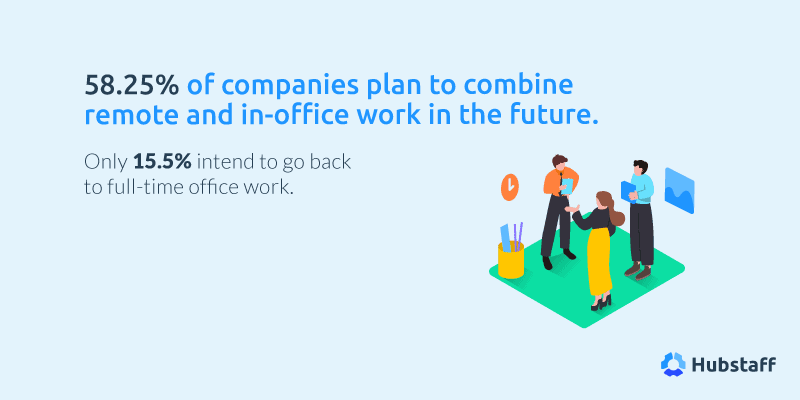
Before the pandemic, 23.25% of businesses reported that they worked remotely. Now, slightly more (25.5%) intend to stay entirely remote for the foreseeable future.
The biggest change is the number of companies who plan to adopt a more flexible work model.
After the pandemic is over, a whopping 58.25% of businesses plan to stay partially remote or offer work-from-home options. That’s a big increase from 25.25% before the pandemic.
That shift is significant.
Before, more than half of the companies surveyed offered no remote work options. Now, only 15.5% plan to return fully to in-office work after the pandemic subsides.
Employees want to continue working from home
It’s possible that employees are pressuring their managers to offer more remote options.
87% of companies say that employees have asked for continued remote work options after the pandemic, where 71.5% received remote work requests before.
Requests also occur at a higher frequency. Before the pandemic, 16% of companies were frequently asked about remote work. Now, 30.75% report that their team often expresses interest in continuing to work remotely.
The increased interest in remote work is at least partially influenced by a concern for health and safety. Even with social distancing and other preventative measures, in-person work has a higher risk of exposure than staying home.
That’s not the whole story, though.
Employees have been requesting the option to work remotely since long before the pandemic, and according to this survey, they’ve responded very positively to work from home arrangements.
This confirms what we at Hubstaff have known for a long time – employees love working remotely.
Need tips for better remote work?
Don’t miss our complete guide with over 100 pages on effective remote team management. Fill out the form below to get it.
What companies expect from post-pandemic remote work
Business owners seem to like remote work, too.
As companies first started closing offices, many seemed to regard remote work as a necessary evil. They anticipated productivity issues, communication breakdowns, and other expensive problems.
That doesn’t seem to be the case now.
Profitability
Few businesses are worried about how remote work is going to hurt them. In fact, most expect it to have a positive impact on their bottom line.
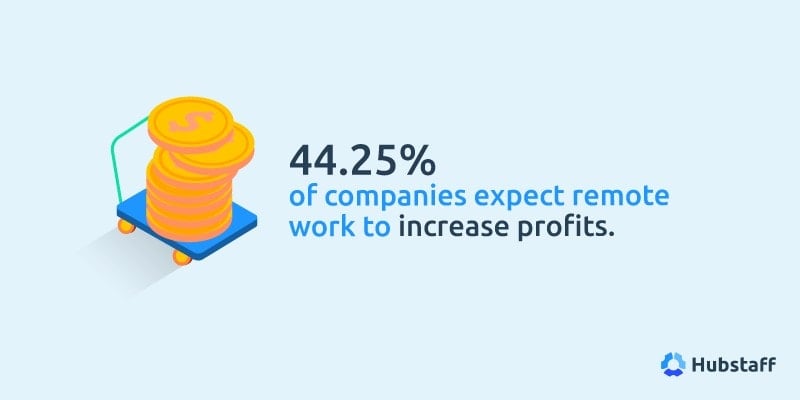
When it comes to profitability, 44.25% of companies expect it to improve thanks to remote work. Only 13.5% expect remote work to negatively impact profits.
Based on years of research and dozens of studies, it’s reasonable to predict that remote work will lead to better profitability.
We’ve seen lots of companies leverage remote work specifically to boost profits. It makes sense because:
- Remote work helps companies reduce expenses – Working remotely saves companies around $11,000 for every employee that works away from the office at least half of the time.
- Working remotely improves employee productivity – 77% of employees say they’re more productive when working remotely.
- Remote workers are more loyal – Remote employees are 13% more likely to stay at their current company compared to in-office workers, reducing expensive turnover costs.
Working remotely during the pandemic is a different situation, but looking towards the future, it seems that many companies expect to see a positive impact.
Productivity
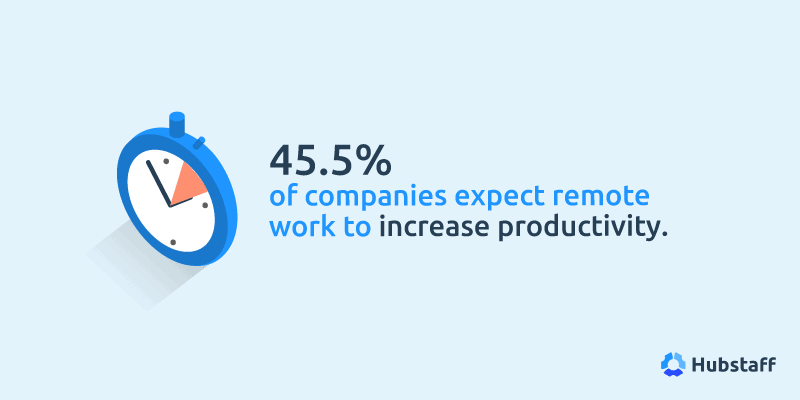
Despite all the evidence that remote work is actually a productivity booster, companies have feared it would lead to lower productivity and therefore denied requests to work remotely.
Remote work aside, it actually makes sense for productivity to plummet during a pandemic. Outside circumstances make it harder to get things done, especially if you have to shelter in place with other family members.
Knowing that so many businesses were attempting to work remotely for the first time during an international crisis, we expected to see a lot of concern about productivity.
Instead, we found that 45.5% of companies predict that their productivity is going to increase as they continue working remotely.
That seems to hint that even during the pandemic, remote workers still get more done. Perhaps pandemic stress has less of a negative impact than expected.
Even though most expect an improvement, 20.75% of businesses anticipate that remote work will hurt their team’s future productivity.
Of all the questions we asked about the future of remote work, we found that productivity was the biggest concern.
Happiness
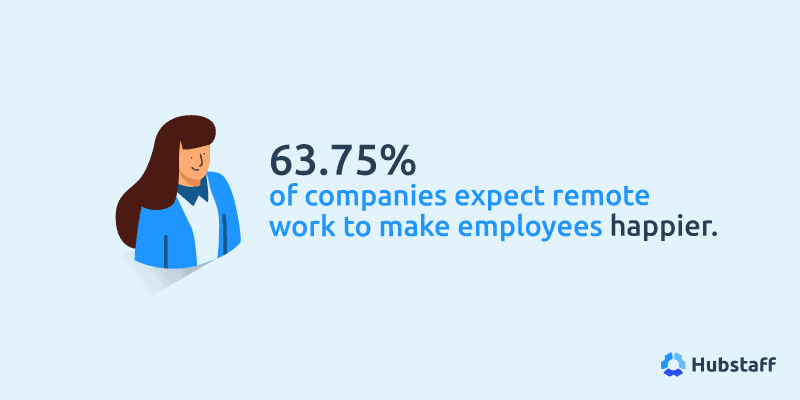
Again and again, the responses in this survey hint at the same finding: offering remote work options makes employees happier.
Most (63.75%) businesses expect remote work to have a positive impact on employee happiness. Just 15.25% said that they don’t expect any difference, while 12.75% think their employees will be less happy.
This data aligns with prior research indicating that remote employees are happier. Owl Labs reports that 71% of remote workers are happy with their job compared to 55% of on-site employees.
Out of all the questions we asked about future expectations, companies expected the highest positive impact on employee happiness.
The impact on different types of businesses
At the end of our survey, we asked two open-ended questions to give companies a chance to share more personalized insights. These open responses added depth to our analysis.
While a lot of comments are similar — “My team enjoys working without a commute, but hates virtual meetings” — it’s clear that the remote experience is not the same for everyone.
The pandemic economy has been easier on companies like web development agencies and grocery delivery services than it has on event caterers and private schools.
Some businesses have had to close completely, and others can’t hire fast enough to keep up with increased demand.
Employees have reacted differently, too. Most have been very positive about remote work, but lots of companies report that some team members have had trouble adjusting. For example, remote work during the pandemic has been harder for single parents helping their kids with distance learning.
As you consider all the interesting findings from this survey, keep this in mind. As compelling as these trends are, every company and employee experiences remote work a little differently.
That means there’s no single policy or strategy that produces great results for everybody all the time.
Key takeaways
Hubstaff has always been an advocate for the benefits of remote work.
Working from home in a pandemic isn’t quite the same thing, though.
There’s a big difference between working remotely because it’s a good choice for your business and working remotely because it’s the only choice you have right now.
Concerns about remote work during the pandemic
Most of the concerns people mentioned are related to the business impacts of the virus. Stress over layoffs, business loss, and safety were common. Some people talked about working from home while trying to homeschool their children.
Complaints about remote work were a little less frequent than pandemic-specific concerns. People miss having social events with their coworkers, and some are concerned about work tasks encroaching on free time.
Lessons learned
It’s clear that going remote has been a learning experience for a lot of companies.
One of the biggest changes we’ve noticed is that businesses are less resistant to remote work after trying it out. A lot of their old arguments against working from home have turned out to be far less problematic than they expected.
In a GetApp survey, the most common reasons that employees weren’t allowed to work from home were:
- The job requires a physical presence
- The job requires in-person collaboration
- Management doesn’t see the value in remote work
With 83.75% of companies planning to offer at least some remote work options after the pandemic, it’s pretty clear that those things aren’t getting in the way as much anymore.
We also noticed how much employees love their new remote working arrangements.
Despite the challenges, it seems that most employees enjoy remote work and want to keep doing it. They requested it before, and now that they’ve taken a test drive, they’re even more interested in working from home.
This indicates that businesses who don’t offer flexible work options in the future might have a tough time finding and retaining talent.
Smart companies should anticipate a much more remote-friendly landscape, even after COVID-19 concerns are a thing of the past.
Over to you
Between 100% remote, 100% in-office, or some combination of the two, what would you choose for your business? Share your thoughts in the comments below.
Most popular
The Fundamentals of Employee Goal Setting
Employee goal setting is crucial for reaching broader business goals, but a lot of us struggle to know where to start. American...
Data-Driven Productivity with Hubstaff Insights: Webinar Recap
In our recent webinar, the product team provided a deep overview of the Hubstaff Insights add-on, a powerful productivity measurem...
The Critical Role of Employee Monitoring and Workplace Security
Why do we need employee monitoring and workplace security? Companies had to adapt fast when the world shifted to remote work...
15 Ways to Use AI in the Workforce
Whether through AI-powered project management, strategic planning, or simply automating simple admin work, we’ve seen a dramatic...
![The Pandemic’s Impact on Remote Work & Where We Go From Here [Report]](https://hubstaff.com/blog/wp-content/uploads/2020/08/Work-from-home-after-covid@2x.jpg)



